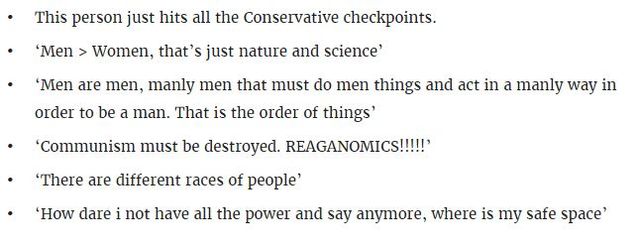Gender
The Google Memo: Race and Gender Gaps and their Solutions
The Science Hardly Matters
Posted August 10, 2017

An employee at Google was recently fired for having the unmitigated gall to post an essay (available in full here) making the following claims:
1. Neither the left nor the right gets diversity completely right; 2. The social science evidence on implicit and explicit bias has been wildly oversold and is far weaker than most people seem to realize; 3. Google has, perhaps unintentionally, created an authoritarian atmosphere that has stifled discussion of these issues by stigmatizing anyone who disagrees as a bigot and instituted authoritarian policies of reverse discrimination; 4. The policies and atmosphere systematically ignore biological, cognitive, educational, and social science research on the nature and sources of individual and group differences.
His review of the science was thoughtful, sophisticated and mostly on target. He probably extrapolated beyond the data itself in some conclusions, such as drawing a fairly direct line from research showing sex differences in agreeableness and assertiveness to gender gaps in leadership. He certainly did not discuss every possible relevant study. But, then, nor do most psychologists; in fact, it is disturbingly common for psychologists to write "scholarly" articles that tell a narrative extolling their Amazing! World-Changing! effect by simply systematically ignoring scholarship that conflicts with their view. Given this, I find it a bit disingenuous to hold this 10 page memo to higher standards than we commonly use in our published literatures!
Furthermore at no point did he argue that such differences constitute justifications for discrimination. He did not present explanations of differences as justifications for the creation of discriminatory policies or barriers. Furthermore, my view is that he did not go beyond the data much more than most psychologists do in the discussion sections of their articles, in their narrative stories about “amazing” findings, or in their rush to create policies based on research that they believe is conclusive but time and skepticism often reveals is not. This may have been suboptimal, but it is hard to hold a layperson culpable for interpretations and extrapolations comparable to that of scientists!
He also made the following recommendations:
1.Demoralize diversity
2.Stop alienating conservatives
3.Confront Google’s Biases
4.Stop restricting (support) programs and classes to certain genders or races.
5.Have an open and honest discussion about the costs and benefits of our [referring to Google’s] diversity
6.Focus on psychological safety, not just race/gender diversity
7.De-emphasize empathy
8.Prioritize intention
9.Be open about the science of human nature
10.Reconsider making Unconscious Bias Training Mandatory for promotion committees
Whether or not you agree with 100% of his recommendations or none, or anything in between (I am in between myself), is not the point. His essay was thoughtful and should be exactly the type of thing that is discussed in almost any corporate, academic, or organizational context.
That is not what happened.
The reaction was swift, emotional, largely irrational, and revoltingly hostile.

The Memo claimed there was a politically stifling and authoritarian atmosphere at Google. And then he was fired. There does not seem to be a lot of work needed to connect those two dots.
Rather than engage the arguments, much of the immediate response (go to the comments here) simply cast the author as a bigot and deny the evidence he presented without presenting a shred of evidence refuting it.
Here is just one example:

The Memo actually says none of these things. A far more profane comment on the memo from the same Gizmodo site can be found here.
Old Slurs/New Slurs
In 1960, the most common slurs were insulting labels for demographic groups. In 2017, the most common slurs involve labeling or implying that anyone who you disagree with on issues such as affirmative action, diversity, explanations for gaps and inequality is a racist, sexist, homophobe, or bigot.
This is not restricted to laypeople making comments. See this LATimes editorial or this Fortune magazine story.
Rather than engaging with the author’s arguments, much of the response has been modern slur-slinging, simply labeling him as an “ist” (racist, sexist, etc.) and dismissing his arguments and analysis without providing any basis whatsoever.1 His arguments have been bizarrely caricaturized as everything from eugenics (attempts to breed humans to improve the species) to a modern incarnation of White Man’s Burden to a "clear and present danger to inclusion". The "clear and present danger" text (in the Fortune piece) is particularly disturbing because it draws a direct parallel between the justification for speech restrictions on yelling "fire" in a crowded theater (i.e., it could create a panic that unnecessarily kills people) and the justification for suppressing speech that summarizes social science evidence on biological bases of group differences!
Equally important, almost none of the responses and criticisms have attempted to refute his arguments or evidence. With all due respect to those of you engaging in this sort of rhetoric, you are likely shooting yourselves in what I suspect is a foot you care a lot about. The more others think your actions constitute politically motivated efforts to suppress others’ freedoms, the more likely your actions are to increase their support for Donald Trump.

I am concerned that this is a watershed, and that we will be in for something like a New Mirror Image McCarthyism. This time, it will be the Left doing the stigmatizing and blacklisting. Last time, the righteous justification was in the name of fighting Communism. This time, it will be in the name of fighting sexism and racism. I am concerned that such stigma and blacklists will include researchers who study group differences, especially evolutionary or biological bases of group differences. I am concerned that it will include anyone who has the temerity to question the wisdom of diversity programs, affirmative action, bias reporting systems, microaggression training, implicit bias training, and the like.
My field is currently obsessed with alleged witch-hunts involving science reform and the replication crisis (the old guard routinely accuses the reformers who criticize their work as engaging in witch-hunts). It is completely blind to the much larger witch-hunting of those who do not tow a very particular set of moral and ideological lines regarding diversity, discrimination, and explanations for group differences. Or, perhaps, much of my field endorses such witch-hunts. I am not sure. Certainly, few are standing up against them.
To be clear, my critique of this sort of reverse McCarthyism does not mean I oppose diversity and inclusion efforts. I am capable of, simultaneously, believing that Communism was an unmitigated horror, responsible for mass murder and misery on an unimaginable scale and at the same time believing that McCarthyism and the blacklists were themselves evil.
Similarly, I can and do believe racism and sexism are evils worth actively combating and at the same time I can and do strongly oppose witch hunts, speech suppression, and firing people for expressing ideas we do not like. I also strongly endorse diversity and inclusion goals, though I might differ from some of my colleagues on how best to advance them. I am one of few faculty I know who actually has a diversity statement on his or her website. You can find it here.
RECOMMENDED READINGS
Editorials/Blogs
Haidt & Jussim, May 16, 2016, Hard Truths about Race on Campus. Wall Street Journal.
Jussim, L. (2017). Why Brilliant Girls Tend to Prefer Non-STEM Careers. Psychology Today.
Jussim, L. (2017). Gender Bias in STEM or Biased Claims of Gender Bias? Psychology Today.
Scholarship
Ceci & Williams (2011). Understanding current causes of women’s underrepresentation in science. Proceedings of the National Academy of Sciences, 108, 3157-3162.
Duarte et al (2015). Political diversity will improve social psychological science. Behavioral and Brain Sciences, doi:10.1017/S0140525X14000430, e130
Pinker, S. (2002). The Blank Slate. New York: Penguin Books
Wang et al (2013). Not lack of ability but more choice: Individual and gender differences in choice in careers in science, technology, engineering and math. Psychological Science, 24, 770-775.
Williams & Ceci (2015). National hiring experiments reveal 2:1 faculty preference for women on STEM tenure track. Proceedings of the National Academy of Sciences, 112, 5360-5365.
-----------------------------------------------------
1 THERE HAS BEEN SOME THOUGHTFUL PUSHBACK AND CRITICISM OF THE GOOGLE ESSAY
This blog post by Adam Grant, an industrial/organizational psychologist at Penn argues that much of the Google Essay gets the science wrong and exaggerates differences between men and women. Two independent essays, one by David Schmitt, a personality psychologist who actually studies sex differences and another by Scott Alexander, contested (and, in my view, carefully refuted) many of Grant’s main conclusions.
Here is just one example. Grant wrote: "When it comes to abilities, attitudes, and actions, sex differences are few and small."
Here is part of Schmitt’s essay:
"Culturally universal sex differences in personal values and certain cognitive abilities are a bit larger in size (see here), and sex differences in occupational interests are quite large2. It seems likely these culturally universal and biologically-linked sex differences play some role in the gendered hiring patterns of Google employees."
Here is part of Alexander’s essay:
"Suppose I wanted to convince you that men and women had physically identical bodies. I run studies on things like number of arms, number of kidneys, size of the pancreas, caliber of the aorta, whether the brain is in the head or the chest, et cetera. 90% of these come back identical – in fact, the only ones that don’t are a few outliers like “breast size” or “number of penises”. I conclude that men and women are mostly physically similar. I can even make a statistic like “men and women are physically the same in 78% of traits”.
I worry that Hyde’s analysis (heavily relied on by Grant) plays the same trick. She does a wonderful job finding that men and women have minimal differences in eg “likelihood of smiling when not being observed”, “interpersonal leadership style”, et cetera. But if you ask the man on the street “Are men and women different?”, he’s likely to say something like “Yeah, men are more aggressive and women are more sensitive”. And in fact, Hyde found that men were indeed definitely more aggressive, and women indeed definitely more sensitive. But throw in a hundred other effects nobody cares about like “likelihood of smiling when not observed”, and you can report that “78% of gender differences are small or zero”.
And here is a quote from Debra Soh's essay, whose work has been in sexual neuroscience:
"Despite how it's been portrayed, the memo was fair and factually accurate. Scientific studies have confirmed sex differences in the brain that lead to differences in our interests and behaviour."
2 A BRIEF BUT IMPORTANT SCIENTIFIC AND LOGICAL SIDE ISSUE
There is a subtle but important difference between claiming
1.“The evidence that exists does not support X or ” or “There is no evidence that supports X”
versus
2. “X is not true.”
X can be true even though the evidence does not support it. There may be life on Mars or Titan or in some distant star system, even though we have no evidence of such life yet.
There is an even bigger difference between claiming:
1. Smith’s (1990) data did not justify Smith’s conclusion that sexism causes the gender gap in STEM
versus
2. Sexism does not cause the gender gap in STEM.
Nearly all of my arguments in this and most of my other blogs are of the first type (#1 in both examples above). One can only begin to reach #2 type conclusions, however tentatively and contingent on new evidence, if one gets the #1 type conclusions correct.
If you say “I know that sexism causes gaps because Smith (1990) showed it!” and I show that, no, in fact, Smith did not show it, this implies two things:
1. You should now change your view about the role of sexism in gaps, unless you can actually show that my reasoning is incorrect
2. Nothing about the actual role of sexism in such gaps. A study failing to show X causes Y does NOT MEAN “X DOES NOT CAUSE Y” – it only means that one cannot infer X causes Y from that study. Perhaps other evidence does or someday will show that X causes Y.
------------------------------------------------------------
PLEASE READ THIS BEFORE COMMENTING. YOU ARE AT RISK OF HAVING YOUR COMMENT REMOVED IF YOU DO NOT.
For this blog and this blog only, I am going to use a very restrictive comments policy: If you wish to disagree with my view here, or if you wish to condemn or criticize the Google Memo, you must actually present evidence in support of your view. And by “evidence,” I mean scientific evidence – references to articles or books that have appeared in the psychological, sociological, business, or other natural or social science literatures. If you do not, I will simply delete your comment. I am taking this unusual step because, overwhelmingly, the condemnation of the Google Memo has been completely vacuous. You can criticize it here, but you better have your actual evidence lined up.
As usual, please read my guidelines for commenting before doing so. In short, no snark, sarcasm, or insults, and please stay on topic.
---------------------------------------------------------------
For updates on new blog entries here, and pieces by others (including their blogs, editorials, long form essays, and scientific articles) on this and related topics, follow us on Twitter.




